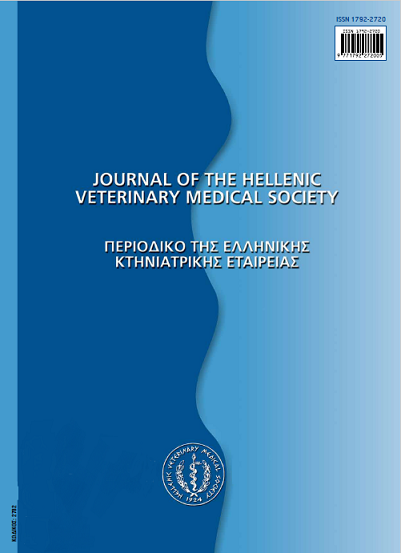Επίμονες ιογενείς λοιμώξεις οε παραγωγικά ζώα και ζώα συντροφιάς: μηχανισμοί εγκατάστασης και διατήρησης αυτών

Περίληψη
Στις επίμονες ιογενείς λοιμώξεις ο εκάστοτε υπεύθυνος ιός δεν εξουδετερώνεται πλήρως από το ανοσοποιητικό σύστημα του ξενιστή, αλλά παραμένει στον οργανισμό για διάστημα μηνών, ετών ή εφ' όρου ζωής και απεκκρίνεται κατά διαστήματαή συνεχώς. Το ζώο φορέας μπορεί να είναι φαινομενικώς υγιές, πιθανόν όμως να εμφανίζει συμπτώματα. Η επιζωοτιολογική σημασίατων επίμονων ιογενών λοιμώξεων είναι μεγάλη, γιατί οι ασυμπτωματικοί φορείς αποτελούν μόνιμη πηγή διασποράς του ίου, τον οποίο μπορεί να μεταφέρουν ακόμη και σε μακρινές αποστάσεις και να τον εισάγουν ξανά σε άλλη εκτροφή, περιοχή ή χώρα που είχαν εξυγιανθεί. Επιπλέον, οι λοιμώξεις αυτές μπορεί να αναζωπυρωθούν, να οδηγήσουν σε νόσημα ανοσολογικής προέλευσης,να συνοδεύονται από νεοπλασίες ή ακόμη να μεταδοθούν σε άλλα ζώα και σε ανθρώπους με τη χρήση μολυσμένων βιολογικών προϊόντων. Οι οικονομικές απώλειες που προκαλούνται στην εκτροφή ή και στο κράτος είναι σημαντικές. Πενήντα τέσσερις RNA και DNA ιοί διαπιστώθηκε ότι προκαλούν επίμονες λοιμώξεις στα παραγωγικά ζώα και τα ζώα συντροφιάς. Συγκεκριμένα,στα βοοειδή επίμονες λοιμώξεις προκαλούν 14 ιοί, στα αιγοπρόβατα 7, στους χοίρους 9, στα ιπποειδή 11, στη γάτα 8 και στο σκύλο 5. Η πλειονότητα των λοιμώξεων αυτών οφείλεται σε ρετροϊους και ερπητοϊους. Η εγκατάσταση και η διατήρηση μιας επίμονης λοίμωξης επιτυγχάνεται με διάφορους μηχανισμούς, όπως με τον περιορισμό της κυτταρολυτικής δράσης του ίου, την επί μακρόν διατήρηση του γενώματός του στο κυτταρικό DNA του ξενιστή και τη διαφυγή από τη δράση του ανοσοποιητικού συστήματος. Τα μέτρα που λαμβάνονται για την προστασία των ζώων αφορούν είτε στην ανοσοποίηση τους είτε στην εκρίζωση του νοσήματος με θανάτωση των μολυσμένων ή καλύτερα όλων των ζώων της εκτροφής.Τα εμβόλια που χρησιμοποιούνται είναι αδρανοποιημένα ή ζωντανά ελαττωμένης λοιμογόνου δύναμης. Τα περισσότερα από αυτά παρασκευάζονται με συμβατικές μεθόδους. Υπάρχουν, όμως, διαθέσιμα και εμβόλια νέας τεχνολογίας, όπως εμβόλια-φορείς, εμβόλια-δείκτες ή εμβόλια υπομονάδων (subunit). Το κύριο πλεονέκτημα της χρήσης των εμβολίων-δεικτών είναι ότι επιτρέπουν τη διάκριση των εμβολιασμένων από τα φυσικά μολυσμένα ζώα.
Λεπτομέρειες άρθρου
- Πώς να δημιουργήσετε Αναφορές
-
PAPANASTASOPOULOU (Μ. ΠΑΠΑΝΑΣΤΑΣΟΠΟΥΛΟΥ) M. (2017). Επίμονες ιογενείς λοιμώξεις οε παραγωγικά ζώα και ζώα συντροφιάς: μηχανισμοί εγκατάστασης και διατήρησης αυτών. Περιοδικό της Ελληνικής Κτηνιατρικής Εταιρείας, 55(4), 353–362. https://doi.org/10.12681/jhvms.15146
- Τεύχος
- Τόμ. 55 Αρ. 4 (2004)
- Ενότητα
- Review Articles
Οι συγγραφείς των άρθρων που δημοσιεύονται στο περιοδικό διατηρούν τα δικαιώματα πνευματικής ιδιοκτησίας επί των άρθρων τους, δίνοντας στο περιοδικό το δικαίωμα της πρώτης δημοσίευσης.
Άρθρα που δημοσιεύονται στο περιοδικό διατίθενται με άδεια Creative Commons 4.0 Non Commercial και σύμφωνα με την άδεια μπορούν να χρησιμοποιούνται ελεύθερα, με αναφορά στο/στη συγγραφέα και στην πρώτη δημοσίευση για μη κερδοσκοπικούς σκοπούς.
Οι συγγραφείς μπορούν να καταθέσουν το άρθρο σε ιδρυματικό ή άλλο αποθετήριο ή/και να το δημοσιεύσουν σε άλλη έκδοση, με υποχρεωτική την αναφορά πρώτης δημοσίευσης στο J Hellenic Vet Med Soc
Οι συγγραφείς ενθαρρύνονται να καταθέσουν σε αποθετήριο ή να δημοσιεύσουν την εργασία τους στο διαδίκτυο πριν ή κατά τη διαδικασία υποβολής και αξιολόγησής της.


